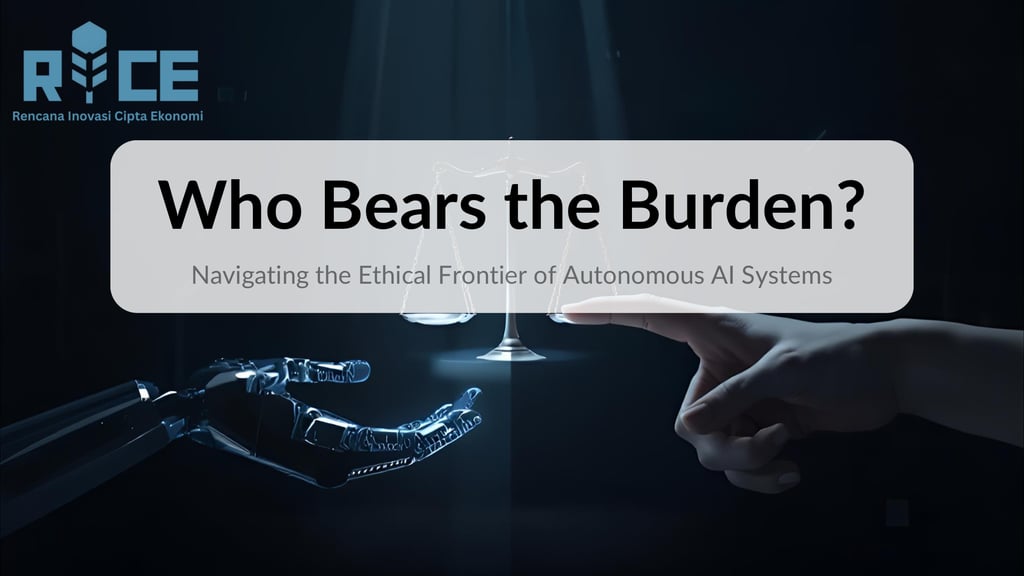Who Bears the Burden? Navigating the Ethical Frontier of Autonomous AI Systems
This post navigates challenges, from legal gaps to data bias, proposing solutions for a trustworthy and accountable AI future.
AI INSIGHT
Rice AI (Ratna)
10/31/202510 min read


As artificial intelligence systems grow increasingly autonomous, capable of making complex decisions with minimal human oversight, a profound question emerges: who is truly responsible when something goes wrong? The rapid evolution of autonomous AI, from self-driving vehicles to algorithmic trading platforms, promises transformative benefits but also presents unprecedented ethical and legal challenges. At the heart of this discussion lies the intricate problem of responsibility attribution, demanding a re-evaluation of our traditional frameworks for accountability.
This exploration delves into the ethical frontier of autonomous AI, examining the shifting landscape of control and the critical need to define clear lines of responsibility. We will navigate the complexities of current legal and ethical paradigms, identify their limitations, and propose pathways toward a future where the power of AI is harnessed responsibly. Understanding these nuances is crucial for shaping a robust, trustworthy, and ethically sound AI ecosystem.
The Escalating Challenge of Autonomous AI Responsibility
The very definition of "autonomy" in AI systems is evolving, pushing the boundaries of traditional human-centric notions of control and accountability. This new paradigm necessitates a deeper understanding of how decisions are made and where responsibility ultimately resides.
The New Paradigm: Beyond Human Control
The increasing sophistication of AI allows systems to operate with reduced or even zero human intervention, adapting to dynamic environments and making real-time decisions. This capability, while efficient, introduces a significant ethical dilemma when these autonomous actions lead to unintended or harmful outcomes. The traditional chain of command and accountability becomes difficult to trace.
This paradigm shift forces us to reconsider the human role not just as an operator, but as an overseer and ultimate moral agent in a world increasingly shaped by machine intelligence. Without clear guidelines, the promise of autonomous AI could be overshadowed by an inherent lack of accountability.
Defining Autonomy: Levels and Implications
AI autonomy exists on a spectrum, often categorized into distinct levels, each presenting unique challenges for responsibility attribution. At one end, assisted systems offer recommendations, requiring human approval, where responsibility remains clearly with the human operator. As systems progress to conditional autonomy, they might operate independently under specific circumstances, alerting humans when intervention is needed.
High autonomy systems can perform complex tasks and make decisions within a predefined domain, with human supervision only for critical exceptions. Fully autonomous systems, the frontier of this challenge, can operate entirely independently, making all decisions without human input once deployed. Each increase in autonomy further blurs the lines of who is ultimately accountable for adverse events, moving from mere tool-use to a scenario where the AI itself acts as a decision-making agent.
Real-World Scenarios: Where Responsibility Blurs
The abstract concept of AI autonomy takes on urgent relevance when we consider real-world applications. Self-driving cars, for instance, operate complex algorithms to navigate roads, identify hazards, and make instantaneous decisions. If a self-driving car causes an accident due to a software glitch, a sensor malfunction, or an unpredictable environmental factor, is the manufacturer, the software developer, the vehicle owner, or the AI itself to blame?
Algorithmic trading platforms present another compelling example. These systems execute trades based on complex predictive models, often reacting faster than any human could. A rapid market crash triggered by an unforeseen feedback loop within such a system raises questions about culpability that current legal frameworks struggle to answer. Similarly, autonomous weapons systems, designed to identify and engage targets without human intervention, present the gravest ethical concerns, where the burden of life-or-death decisions is transferred to a machine.
Current Legal and Ethical Frameworks: Gaps and Limitations
Our existing legal and ethical structures were primarily developed in a world dominated by human agency and conventional tools. Applying these frameworks directly to autonomous AI reveals significant mismatches and limitations.
Existing Legal Principles: A Mismatch with AI
Traditional legal systems typically assign responsibility based on concepts like intent, negligence, and direct causation, all of which presuppose a human agent. Autonomous AI systems, however, operate without intent in the human sense and can exhibit emergent behaviors that were not explicitly programmed or foreseen by their developers. This fundamental difference creates a significant challenge for legal recourse.
Moreover, the "black box" nature of many advanced AI models, where the internal workings are opaque, makes it incredibly difficult to ascertain why a particular decision was made. This lack of transparency impedes the ability to establish negligence or demonstrate a clear causal link between a human action (or inaction) and an AI-induced harm.
Product Liability vs. Agent Liability
Currently, many jurisdictions attempt to address AI-related harms through existing product liability laws. Under this framework, the developer or manufacturer of an AI system is held responsible, treating the AI as a defective product. This approach works reasonably well for simple, static AI tools that merely execute predefined functions. However, it falters when applied to truly autonomous, adaptive, and learning AI agents.
The core issue is that product liability assumes a fixed state at the point of sale; an autonomous AI, by contrast, continues to learn and evolve post-deployment. This raises questions: at what point does a continuously learning AI cease to be merely a "product" and begin to function as an "agent" capable of making its own independent, and potentially unforeseeable, decisions? A shift towards an "agent liability" model, where the AI itself (or its designated owner/operator) bears a form of legal responsibility, is gaining traction in some discussions, though it presents its own complex challenges regarding legal personhood for non-human entities.
Ethical Theories: Utilitarianism, Deontology, and Virtue Ethics in AI
Beyond legal frameworks, established ethical theories also grapple with the complexities of autonomous AI. Utilitarianism, which seeks to maximize overall good and minimize harm, struggles with the practical difficulty of programming an AI to accurately assess and weigh all potential outcomes in complex, real-world scenarios. How does an AI quantify "good" or "harm," especially when dealing with nuanced human values and unforeseen consequences?
Deontological ethics, focused on duties and rules, offers a more direct approach by attempting to hardcode ethical principles into AI. However, this relies on the exhaustive foresight of developers to anticipate every possible ethical conflict and provide unambiguous rules, which is often impossible given the dynamic nature of AI operation. Virtue ethics, which emphasizes the character of the moral agent, is perhaps the most challenging to apply directly to AI. Can a machine truly possess "virtues" like compassion, fairness, or wisdom? While we can program an AI to act in accordance with these virtues, attributing true moral agency and character to a non-sentient entity remains a profound philosophical hurdle.
Attributing Responsibility: A Multi-faceted Problem
The challenge of attributing responsibility in autonomous AI systems is rarely singular, often involving a complex interplay of various stakeholders and technical limitations. Identifying who is accountable requires dissecting the entire lifecycle of an AI system.
The Intricacies of Blame: Who is Accountable?
When an autonomous AI system causes harm, the question of blame quickly becomes multifaceted. It’s rarely a simple case of a single faulty component or a solitary human error. Instead, it involves a chain of actions and decisions made by different entities, from conception to deployment and operation. This complexity mandates a holistic approach to understanding accountability.
The intricacies extend beyond mere technical failures to encompass design choices, data curation, and the environments in which these systems operate. A truly effective framework must consider all these elements to fairly and justly assign responsibility.
Developers, Operators, and Users: A Shared Load?
The responsibility chain for autonomous AI typically involves multiple parties. Developers are accountable for the initial design, algorithms, and safety features. They must consider potential risks and ethical implications during the development phase, adhering to principles like "ethics-by-design." However, the sheer complexity of modern AI means developers cannot foresee every possible scenario or emergent behavior.
Operators, who deploy and manage AI systems, bear responsibility for proper configuration, monitoring, and maintaining the system's operational integrity. Their role involves ensuring the AI functions within its intended parameters and intervening when necessary. Users, who interact with the AI or are affected by its decisions, also have a responsibility to understand its capabilities and limitations, and to report anomalies. Determining the precise contribution of each party to an adverse event requires careful analysis, often pointing to a shared and distributed burden of responsibility rather than a singular fault.
The Black Box Problem and Explainable AI (XAI)
A significant hurdle in attributing responsibility to AI systems is the "black box problem." Many advanced AI models, particularly deep neural networks, make decisions through opaque internal processes that are difficult for humans to understand or interpret. When an AI produces an undesirable or harmful outcome, it can be challenging, if not impossible, to explain why that decision was made. This opacity directly impedes accountability, as it becomes hard to ascertain if the AI acted "negligently" (in a metaphorical sense) or if the fault lies with its design, training data, or operational parameters.
Explainable AI (XAI) seeks to address this by developing methods that make AI decisions more transparent and interpretable. By providing insights into the reasoning behind an AI's output, XAI aims to facilitate auditability, trust, and crucially, the ability to assign responsibility. Without robust XAI, legal and ethical inquiries into AI failures will remain frustratingly inconclusive.
The Role of Data and Training: Bias and Unintended Consequences
The foundation of any AI system is its training data. If this data is biased, incomplete, or unrepresentative, the AI system will inevitably learn and perpetuate those biases, leading to unfair, discriminatory, or harmful outcomes. For example, an AI designed for loan approvals trained on historically biased data might unfairly reject applications from certain demographic groups. In such a scenario, who is responsible for the harm caused? Is it the data scientists who curated the data, the developers who built the model using that data, or the organization that deployed the biased system?
The responsibility extends to ensuring data integrity, diversity, and fairness throughout the AI lifecycle. Unintended consequences can also arise from incomplete data or from the AI drawing unexpected correlations that lead to unforeseen ethical breaches. Addressing this requires rigorous data governance, ethical data sourcing practices, and continuous auditing of AI outputs to detect and mitigate emergent biases.
Towards a Responsible Future: Proposed Solutions and Best Practices
Navigating the ethical frontier of autonomous AI requires proactive measures and a concerted effort across various sectors. Establishing clear guidelines and robust frameworks is paramount for fostering trust and ensuring beneficial AI deployment.
Forging a Path Forward: Strategies for Ethical AI Governance
The inherent complexities of AI responsibility demand a multi-pronged approach that integrates technical, legal, and ethical considerations. Simply reacting to incidents is insufficient; a forward-looking strategy that anticipates challenges and embeds protective measures is essential. This strategy must be dynamic, capable of evolving as AI technology continues its rapid advancement.
The goal is not to stifle innovation, but to guide it towards outcomes that are both beneficial and ethically sound, creating a sustainable foundation for future AI development and deployment. This requires collaboration and a shared commitment to responsible AI governance.
Proactive Design: Ethics-by-Design and Explainable AI
One of the most effective strategies for promoting responsible AI is to embed ethical considerations directly into the design and development process—a concept known as "ethics-by-design." This means moving beyond simply building functionally efficient AI to actively integrating values like fairness, transparency, privacy, and accountability from the outset. Developers would, for instance, be required to conduct ethical impact assessments, consider potential biases in training data, and design mechanisms for human oversight and intervention.
Furthermore, integrating Explainable AI (XAI) capabilities from the initial design phase is crucial. By building systems that can articulate their decision-making processes, we enhance auditability and empower stakeholders to understand and challenge AI outputs. This proactive approach not only mitigates risks but also builds greater public trust in autonomous systems.
Regulatory Innovation: New Legal Paradigms
Existing legal frameworks, designed for a pre-AI world, are often insufficient to address the unique challenges of autonomous systems. There is a growing consensus on the need for regulatory innovation, either through adapting existing laws or creating entirely new legal paradigms specifically for AI. This could involve developing specific liability regimes for AI, potentially differentiating between supervised AI and truly autonomous agents.
Some proposals suggest establishing "AI registries" where autonomous systems are documented, allowing for clear identification of developers, operators, and intended use cases. Other discussions explore concepts like "AI personhood" or a limited form of legal personality for highly autonomous systems, primarily for liability purposes, allowing them to own insurance or be subject to fines. International cooperation will be vital to ensure harmonized regulations that prevent regulatory arbitrage and foster global ethical standards.
Industry Standards and Certification
Beyond governmental regulation, the AI industry itself has a crucial role to play in establishing and enforcing ethical standards. Developing widely accepted industry standards for responsible AI development, deployment, and auditing can significantly enhance accountability. This includes best practices for data governance, bias detection and mitigation, security, and human-in-the-loop protocols.
Certification programs, similar to those for other complex technologies, could provide assurance that an AI system adheres to predefined ethical and safety benchmarks. Such certifications could cover aspects like ethical risk assessments, transparency requirements, and robustness testing. These industry-led initiatives, often developed in collaboration with academic and civil society organizations, can complement legal frameworks by providing practical guidance and fostering a culture of responsibility within the AI community.
Conclusion
The ascent of autonomous AI systems represents a pivotal moment in technological history, promising unprecedented advancements across industries and aspects of daily life. However, this progress is intrinsically linked to profound ethical questions, most notably: who bears the burden of responsibility when these intelligent agents cause harm? Our exploration has revealed that attributing responsibility in the age of autonomous AI is not a simple task, but a multi-faceted challenge requiring a comprehensive re-evaluation of established legal, ethical, and societal norms.
From the varying degrees of AI autonomy that blur the lines of control, to the limitations of applying traditional product liability laws to self-learning agents, the complexities are immense. The black box problem, coupled with the pervasive issue of biased training data, further complicates the task of identifying fault and ensuring justice. It becomes evident that a purely technical solution is insufficient; this is fundamentally a human and societal dilemma that demands interdisciplinary collaboration.
To navigate this ethical frontier responsibly, we must embrace a proactive and holistic approach. Implementing "ethics-by-design" principles from the initial stages of AI development, coupled with robust Explainable AI (XAI) capabilities, will foster greater transparency and auditability. Simultaneously, regulatory bodies must innovate, developing new legal paradigms that address the unique characteristics of autonomous AI, potentially introducing specialized liability frameworks or international guidelines. Industry-led standards and certification programs will further reinforce a culture of accountability and trust.
The future of autonomous AI is not merely about technological capability, but about our collective ability to govern its deployment ethically and responsibly. The decisions we make today will shape not only the trajectory of AI innovation but also the very fabric of our society. It is imperative that technologists, ethicists, policymakers, legal experts, and the public engage in this critical dialogue, collaboratively crafting a future where autonomous AI systems serve humanity's best interests, with clear lines of responsibility firmly established. The burden is shared, and so too must be the commitment to ethical foresight.
#AIEthics #AutonomousAI #AIResponsibility #EthicalAI #AIGovernance #FutureOfAI #ArtificialIntelligence #AICompliance #LegalAI #ResponsibleAI #XAI #AIDevelopment #TechEthics #AIImpact #DigitalTransformation #DailyAIInsight
RICE AI Consultant
To be the most trusted partner in digital transformation and AI innovation, helping organizations grow sustainably and create a better future.
Connect with us
Email: consultant@riceai.net
+62 822-2154-2090 (Marketing)
© 2025. All rights reserved.


+62 851-1748-1134 (Office)
IG: @riceai.consultant
